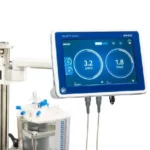
Revolutionizing Patient Care: SonoTT aQuila System Sets New Standard in Blood Flow Measurement
28 Mar 2024
Load cells are force transducers that convert changes in pressure or force into a more tangible, measurable, electric output. They come in a wide array of variants for a number of different applications such as assembly lines and infant incubators.
The way a load cell works is defined by what type of signal it outputs, as well as how it detects weight, meaning that the methods employed vary greatly from variant to variant.
Usually mounted to parts of a structure that contort when weight is placed on them, strain gauge load cells convert said weight into electrical signals. Strain gauges are usually constructed of tough metals such as stainless steel and aluminum, making them a rugged and hard-wearing solution.
In most applications, four strain gauges will be used, with two in compression and the others in tension. The electrical resistance of the gauges then changes according to the load placed on them. The applied force will deform the strain gauge cell, but it will always return to its original form unless overloaded. The high accuracy of strain gauges coupled with their relatively low cost have quickly turned them into the most popular load cell solution.
These load cells use the principle of magnetostriction, a process which senses changes in permeability in ferromagnetic materials when weight/stress is applied. The sensor itself is composed of layers of lamination which creates a load-bearing column that surrounds primary and secondary transformer windings.
When weight/stress is applied to a magnetostrictive load cell, it deforms the flux pattern (the distribution of lines in the magnetic field), creating an output signal according to the load. Magnetostrictive load cells are one of the more rugged load cell options and are ideal for applications such as steel mills.
Similar to magnetostrictive cells, these cells respond to distortion of a ferromagnetic core proportional to force applied. The inductive load cell changes a solenoid core’s inductance whilst the reluctance load cell changes the reluctance of a minute air gap.
Hydraulic load cells are force-balanced devices. They are comprized of a cylinder and piston setup which compresses fluid in a diaphragm chamber, thus measuring weight as internal fluid pressure changes. Put simply, as the force is increased, the pressure of the fluid increases with it. Hydraulic load cells are usually used to measure smaller weights where a high level of safety and sanitation are key.
Pneumatic load cells are similar to hydraulic load cells in that they both work on the force-balance principle and have similar applications. They are constructed of a corrugated diaphragm, an air supply regulator, a nozzle, a pressure gauge and a flapper above said nozzle. Pressure is applied to the diaphragm then released through a nozzle at the bottom of the cell. The pressure is then measured using the aforementioned pressure gauge.
Load cells are now the preferred solution in the majority of weighing applications. Some of the more common, everyday applications of load cells include self-service checkouts (usually in the ‘bagging area’), domestic scales such as bathroom scales and kitchen scales and luggage weighers in airports.
When it comes to industry specific applications, load cells can commonly be found in on-board weighing, platform weighing, medical equipment such as devices that measure the tension force applied by the weight of an IV bag and agriculture produce weighing.